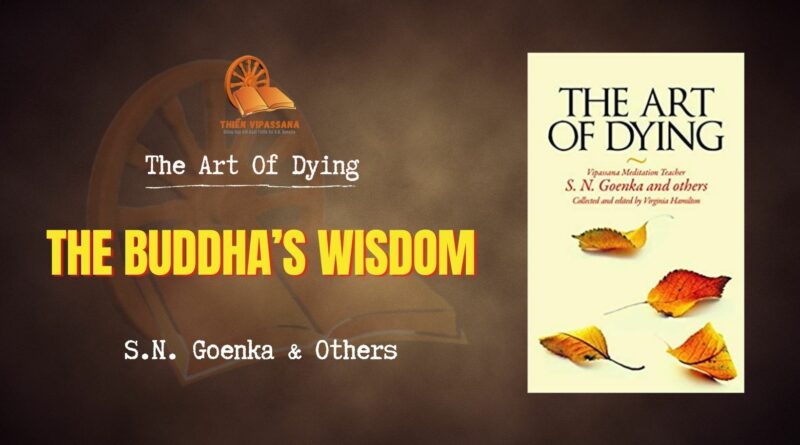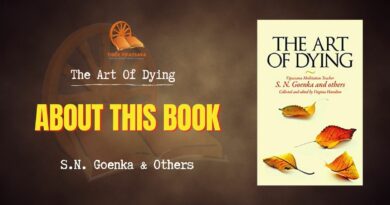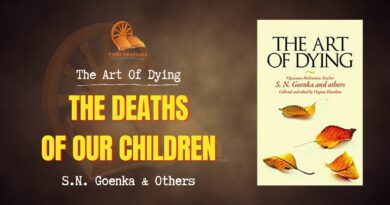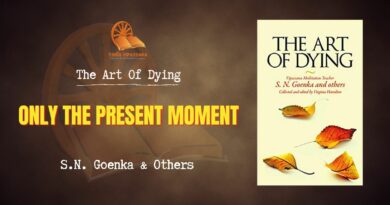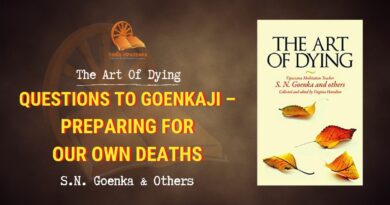The Buddha’s Wisdom
The Buddha taught Four Noble Truths, applicable to everyone. The First Noble Truth states that inherent in all things are the seeds of dissatisfaction that inevitably lead to suffering, both mental and physical.
This is so, the Buddha realized, because everything in the universe is changing, in a state of constant flux, impermanent and insubstantial. Nothing remains the same even for a moment.
On some personal level we, too, recognize this: a sense that everything is not right, that something is missing, or might be impossible to keep if acquired. Circumstances change; what we previously wanted no longer matters. Control is erratic, if not illusory. Fleeting pleasures give no lasting satisfaction; genuine fulfillment seems remote, elusive and ephemeral—beyond our grasp.
This insecurity impels us to search for something constant, dependable and secure—something pleasant that will guarantee permanent happiness. However, since everything is in perpetual flux, the quest is fundamentally futile. This fact of incessant craving for satisfaction is the Second Noble Truth.
Through his supreme efforts, the Buddha realized the Third Noble Truth: there can be an end to the suffering we experience in life.
The Fourth Noble Truth is the Eightfold Noble Path, the way that leads to real peace and real liberation. This Path has three divisions: sīla (morality), samādhi (concentration, or mastery over the mind), and paññā (wisdom, or purification of mind).
Morality is a training to refrain from actions—mental, verbal and physical—that might harm others or ourselves. Making effort to live a wholesome life is a necessary base for learning to control the mind. The second division of the Path is development of concentration, a deeper training to calm the mind and train it to remain one-pointed. The third division, the acquisition of wisdom, is achieved through Vipassana meditation, the technique the Buddha discovered to completely eradicate the conditioning and habit patterns that reinforce our unhappiness and dissatisfaction.
The Buddha said that purification of mind is a long path, one that can take many lifetimes to complete. He taught that we have lived through an incalculable number of lives, cycles upon cycles of life and death—some full of bliss, some tormented, all laced with good and bad, pleasant and unpleasant, all lived in reactive blindness to the reality within.
If we are fortunate enough to hear about Vipassana, if we are ready to learn, to make changes in our lives, we might take the practice to heart and begin to dismantle these patterns of reaction conditioned by ignorance. We notice that we seem happier and more stable, less reactive and more tolerant of others. We want to learn more. We begin to share the Dhamma with others. But common questions persist: How will I be at death? Will I be serene? Will I be strong enough to face death peacefully?
Death, the inevitable ending of life, is feared by nearly all. It is often mired in pain and suffering, of both body and mind. Yet the Buddha taught that death is a pivotal moment on the path to freedom from suffering.
At the moment of death a very strong saṅkhāra (mental conditioning) will arise in the conscious mind. This saṅkhāra generates the necessary impetus for new consciousness to arise in the next life, a consciousness bearing the qualities of this saṅkhāra. If the saṅkhāra is characterized by unhappiness or negativity, the new consciousness will arise in similar negativity and unhappiness. If, on the other hand, it is replete with virtue and contentment, then this rebirth is likely to be wholesome and happy.1
Developing a balanced moment-to-moment awareness of the impermanence of physical sensations in our daily lives, even in the most difficult situations, also creates very deep saṅkhāras— positive ones. If the saṅkhāra of awareness with the understanding of anicca (the constantly changing nature of all
1 Whether we believe in rebirth or not, practicing Vipassana meditation makes our lives easier to live no matter what the situation. We learn how to establish a balanced mind that becomes a strong habit pattern that will help us through all of life’s challenges, even death. things) is strengthened and developed, then this saṅkhāra will arise at death to give a positive push into the next life. The mental forces at the instant of death will carry us, as Goenkaji says, “magnetically,” into a next life in which Vipassana can continue to be practiced.
Walking on the Eightfold Noble Path is an art of living. Living a life in Dhamma—a life of virtue, awareness, and equanimity—not only enhances our daily existence, it also prepares us for the moment of death and for the next life. A calm awareness of anicca at death is a telling measure of progress in mastering the art of living, of progress on the path of peace, the path to nibbāna.
Āo logoṅ jagata ke,
caleṅ Dharama ke pantha.
Isa patha calate satpuruṣha,
isa patha calate santa.
Dharma pantha hī śhānti patha.
Dharma pantha sukha pantha.
Jisane pāyā Dharma patha, maṅgala milā ananta.
Āo mānava-mānavī,
caleṅ Dharama ke pantha.
Kadama-kadama calate hue,
kareṅ dukhoṅ kā anta.
Come, people of the world! Let us walk the path of Dhamma. On this path walk holy ones; on this path walk saints
The path of Dhamma is the path of peace; the path of Dhamma is the path of happiness. Whoever attains the path of Dhamma gains endless happiness.
Come, men and women! Let us walk the path of Dhamma. Walking step by step, let us make an end of suffering.
—Hindi dohas from Come People of the World, S.N. Goenka
Yathāpi vātā ākāse vāyanti vividhā puthū;
Puratthimā pacchimā cāpi, uttarā atha dakkhiṇā.
Sarajā arajā capi, sītā uṇhā ca ekadā;
Adhimattā parittā ca, puthū vāyanti mālutā.
Tathevimasmiṃ kāyasmiṃ samuppajjanti vedanā;
Sukhadukkhasamuppatti, adukkhamasukhā ca yā.
Yato ca bhikkhu ātāpi, sampajaññaṃ na riñcati;
Tato so vedanā sabbā, parijānāti paṇḍito.
So vedanā pariññāya diṭṭhe dhamme anāsavo;
Kāyassa bhedā dhammaṭṭho, saṅkhyaṃ nopeti vedagū.
Through the sky blow many different winds, from east and west, from north and south, dust-laden and dustless, cold as well as hot, fierce gales and gentle breezes—many winds blow. In the same way, in this body, sensations arise, pleasant, unpleasant, and neutral. When a meditator, practicing ardently, does not neglect the faculty of thorough understanding, then such a wise person fully comprehends all sensations, and having fully comprehended them, within this very life becomes freed from all impurities. At life’s end, such a person, being established in Dhamma and understanding sensations perfectly, attains the indescribable stage.
—Paṭhama-ākāsa Sutta, Saṃyutta Nikāya 1.260
Ahaṅkāra hī janma kā,
jarā mṛityū kā mūla.
Ahaṅkāra mite binā,
miṭe na bhāva-bhaya śhūla.
Self-centeredness is the root
of birth, decay and death.
Unless ego is removed,
the torment and fear of becoming will not end.
—Hindi doha, S.N. Goenka
Bài viết này được trích từ cuốn sách The Art of Dying – Thiền Sư S.N.Goenka và nhiều tác giả khác.

